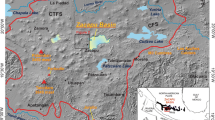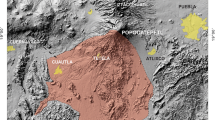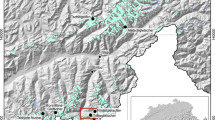Abstract
Pelado, Guespalapa, and Chichinautzin monogenetic scoria cones located within the Sierra del Chichinautzin Volcanic Field (SCVF) at the southern margin of Mexico City were dated by the radiocarbon method at 10,000, 2,800–4,700, and 1,835 years b.p., respectively. Most previous research in this area was concentrated on Xitle scoria cone, whose lavas destroyed and buried the pre-Hispanic town of Cuicuilco around 1,665±35 years b.p. The new dates indicate that the recurrence interval for monogenetic eruptions in the central part of the SCVF and close to the vicinity of Mexico City is <2,500 years. If the entire SCVF is considered, the recurrence interval is <1,700 years. Based on fieldwork and Landsat imagery interpretation a geologic map was produced, morphometric parameters characterizing the cones and lava flows determined, and the areal extent and volumes of erupted products estimated. The longest lava flow was produced by Guespalapa and reached 24 km from its source; total areas covered by lava flows from each eruption range between 54 (Chichinautzin) and 80 km2 (Pelado); and total erupted volumes range between 1 and 2 km3/cone. An average eruption rate for the entire SCVF was estimated at 0.6 km3/1,000 years. These findings are of importance for archaeological as well as volcanic hazards studies in this heavily populated region.














Similar content being viewed by others
References
Arce JL, Macías JL, Vázquez-Selem L (2003) The 10.5 Ka Plinian eruption of Nevado de Toluca Volcano, Mexico: stratigraphy and hazard implications. Geol Soc Am Bull 115:230–248
Arana-Salinas L (1998) Geología del Volcán Pelado. Tesis de Licenciatura, Facultad de Ingeniería, UNAM, Mexico, pp 1–57
Bloomfield K (1973) The age and significance of the Tenango basalt, Central Mexico. Bull Volcanol 37:586–595
Bloomfield K (1975) A late-Quaternary monogenetic volcano field in central Mexico. Geol Rundsch 64:476–497
Conway FM, Connor CB, Hill BE, Condit CD, Mullaney K, Hall CM (1998) Recurrence rates of basaltic volcanism in SP cluster, San Francisco volcanic field, Arizona. Geology 26:655–658
Crane HR, Griffin, JB (1958) University of Michigan radiocarbon dates III. Science 128:1117–1123
Cummings B (1923) Ruins of Cuicuilco may revolutionize our history of ancient America: lofty mound sealed and preserved by great lava flow for perhaps seventy centuries is now being excavated in Mexico. Nat Geogr Mag 40:203–220
Cummings B (1933) Cuicuilco and the Archaic culture of Mexico. Univ Ariz Bull 4:1–56
Delgado H, Arana-Salinas L, Nieto-Obregón J, Mendoza-Rosales C, Silva-Romo G (1997) Pelado Volcano in southern Mexico City, a young monogenetic volcano (<1,000 years old) and its possible impact in human settlements. In: Abstracts of the IAVCEI General Assembly, Puerto Vallarta, Jan 19–24, 1997, p 123
Fedotov SA, Markhinin YK (1983) The great Tolbachik fissure eruption, 1975–1976. Cambridge University Press, Cambridge, pp 1–341
Fries C (1962) Bosquejo geológico de las partes central y occidental del Estado de Morelos y areas contiguas de Guerrero y México. 20th Int. Geol. Congr. 1956, México, Field trip guide C-9, UNAM, México, pp 17–53
González S, Pastrana A, Siebe C, Duller G (2000) Timing of the prehistoric eruption of Xitle volcano and the abandonment of Cuicuilco pyramid, southern Valley of Mexico. In: McGuire B, Griffiths D, Stewarts I (eds) The archaeology of geological catastrophes. Geol Soc London, Spec Publ 171, pp 205–224
Gunn BM, Mooser F (1971) Geochemistry of the volcanics of central Mexico. Bull Volcanol 34:577–616
Heizer RF, Bennyhoff JA (1958) Archeological investigations of Cuicuilco, Valley of Mexico. Science 127:232–233
Herrero E, Pal S (1978) Paleomagnetic study of Sierra de Chichinautzin. Geofis Int 17:167–180
Heydenreich D (1975) Los primeros centros ceremoniales. La cuenca de México. In: Piña C (ed) Panorama histórico y cultural: del nomadismo a los centros ceremoniales. INAH, México, pp 263–281
Kirianov VY, Koloskov AB, De la Cruz S, Martin AL (1990) The major stages of manifestation of recent volcanism in the Chichinautzin zone. USSR Academy of Sciences, Geol Ser 311:432–434
Libby WF (1955) Radiocarbon dating, 2nd edn. University of Chicago Press, Chicago, 175 pp
Lugo-Hubp J (1984) Geomorfología del Sur de la Cuenca de México. Instituto de Geografía, UNAM, Mexico, Serie Varia 1(8):1–95
Luhr JF, Simkin T (1993) Paricutín, the volcano born in a cornfield, Geoscience Press, Phoenix, Arizona, pp 1–427
Macías JL, García PA, Arce JL, Siebe C, Espíndola JM, Komorowski JC, Scott K (1997) Late Pleistocene-Holocene cataclysmic eruptions at Nevado de Toluca and Jocotitlán volcanoes, central Mexico. In: Link KP, Kowallis BJ (eds) Proterozoic to recent stratigraphy, tectonics, and volcanology: Utah, Nevada, southern Idaho and central Mexico, vol 42, No 1. Guidebook of Geological Excursions for the 1997 Annual Meeting of the Geological Society of America, Salt Lake City, Utah, Brigham Young University Geology Studies, pp 493–528
Márquez A, Verma SP, Anguita F, Oyarzun R, Brandle JL (1999) Tectonics and volcanism of Sierra Chichinautzin: extension at the front of the central Trans-Mexican Volcanic Belt. J Volcanol Geother Res 93:125–150
Martin AL (1982) Monogenetic vulcanism in Sierra Chichinautzin, Mexico. Bull Volcanol 45:9–24
Millón R (1994) Teotihuacán. Scientific American Special Issue on ancient cities, vol 5, No 1, pp 138–148
Mooser F (1963) Historia tectónica de la Cuenca de México. Bol Assoc Mex Geól Petrol 15:239–245
Mooser F, Nairn AEM, Negendank JFW (1974) Palaeomagnetic investigations of the Tertiary and Quaternary igneous rocks (VIII): a paleomagnetic and petrologic study of volcanics of the Valley of Mexico. Geol Rundsch 63:451–483
Newhall CG, Self S (1982) Volcanic explosivity index (VEI): an estimate of explosive magnitude for historical volcanism. J Geophys Res 87:1231–1238
Ordoñez E (1938) Tepoztlán, Estado de Morelos. Bol Soc Geol Mex 10:91–112
Panfil MS, Gardner TW, Hirth KG (1999) Late Holocene stratigraphy of the Tetimpa archaeological site, northeast flank of Popocatépetl volcano, central Mexico. Geol Soc Am Bull 111:204–218
Pearson GW, Stuiver M (1993) High precision bidecal calibration of the radiocarbon time scale, 500–2,500 b.c. Radiocarbon 35:24–34
Plunket P, Uruñuela G (1998) Preclassic household patterns preserved under volcanic ash at Tetimpa, Puebla, México. Lat Am Antiquity 9(4):287–309
Porter SC (1972) Distribution, morphology, and size frequency of cinder cones on Mauna Kea Volcano, Hawaii. Geol Soc Am Bull 83:3607–3612
Porter-Weaver M (1993) The Aztecs, the Maya, and their predecessors, Academic Press, New York, pp 1–567
Rodríguez-Lara VC (1997) Evolución del conjunto volcánico Guespalapa y del volcán Chichinautzin, Distrito Federal-Morelos, México. Tesis Licenciarura, ESIA-IPN, México, pp 1–124
Rowland SK, Walker GPL (1990) Pahoehoe and aa in Hawaii: volumetric flow rate controls the lava structure. Bull Volcanol 52:615–628
Sanders W, Parsons J, Santley R (1979) The basin of Mexico, ecological processes in the evolution of a civilization. Academic Press, New York, pp 1–561
Sarmiento G (1994) La creación de los primeros centros de poder. In: Manzanilla L, López-Luján L (eds) El México antiguo, sus areas culturales, los orígenes y el horizonte Preclásico, Historia antigua de México, vol 1. Miguel Angel Porrúa, México, pp 247–277
Scandone R (1979) Preliminary evaluation of the volcanic hazard in the southern Valley of Mexico. Geofis Int 18:21–35
Siebe C (2000) Age and archaeological implications of Xitle volcano, southwestern Basin of Mexico City. J Volcanol Geotherm Res 104:45–64
Siebe C, Macías JL, Abrams M, Rodríguez-Elizarrarás S, Castro R, Delgado H (1995) Quaternary explosive volcanism and pyroclastic deposits in east central Mexico: implications for future hazards. Field trip guide, Geol. Soc. Am. Annual Meeting 1995, New Orleans, Louisiana, pp 1–47
Siebe C, Abrams M, Macías JL, Obenholzner J (1996) Repeated volcanic disasters in Prehispanic time at Popocatépetl, central Mexico: past key to the future? Geology 24:399–402
Siebe C, Schaaf P, Urrutia-Fucugauchi, J (1999) Mammoth bones embedded in a late Pleistocene lahar from Popocatépetl volcano, near Tocuila, central Mexico. Bull Geol Soc Am 111:1550–1562
Siebe C, Rodríguez-Lara VC, Schaaf P, Abrams M (2003) Geochemistry, Sr–Nd isotope composition, and tectonic setting of Holocene Pelado, Guespalapa, and Chichinautzin scoria cones, south of Mexico City. J Volcanol Geotherm Res (in press)
Stuiver M, Becker B (1993) High-precision decadal calibration of the radiocarbon time scale, 1950 a.d.–6,000 b.p. Radiocarbon 35:35–36
Stuiver M, Pearson GW (1993) High-precision decadal calibration of the radiocarbon time scale, 1950 a.d.–500 b.c. and 2500–6000 b.c. Radiocarbon 35:1–23
Swinamer RT (1989) The geomorphology, geochemistry and petrogenesis of the volcanic rocks in the Sierra del Chichinautzin, Mexico. MSci. Thesis, Queen's University, Kingston, Ontario, pp 1–212
The Joint Academies Committee on the Mexico City water supply (1995) Mexico City's water supply: improving the outlook for sustainability. National Academy Press, Washington, DC, pp. 1–107
Tokarev, PI (1983) Calculation of the magma discharge growth in the height of the cone and dimensions of the feeder channel of Crater I in the Great Tolbachik Fissure Eruption, July 1975. In: Fedotov SA, Markhinin YK (eds) The great Tolbachik fissure eruption. 1975–1976. Cambridge University Press, Cambridge, pp 27–35
Urrutia Fucugauchi J, Martin AL (1993) Implicaciones de los datos paleomagnéticos sobre la edad de la Sierra Chichinautzin, Cuenca de México. Geof Int 32:523–533
Verma SP (1999) Geochemistry of evolved magmas and their relationship to subduction-unrelated mafic volcanism at the volcanic front of the central Mexican Volcanic Belt. J Volcanol Geotherm Res 93:151–171
Walker GPL (1971) Compound and simple lava flows and flood basalts. Bull Volcanol 35:579–590
Walker GPL (1973) Length of lava flows. Philos Trans R Soc Lond 274:107–118
Wallace PJ, Carmichael ISE (1999) Quaternary volcanism near the Valley of Mexico: implications for subduction zone magmatism and the effects of crustal thickness variations on primitive magma compositions. Contrib Mineral Petrol 135:291–314
Wood CA (1980a) Morphometric evolution of cinder cones. J Volcanol Geotherm Res 7:387–413
Wood CA (1980b) Morphometric analysis of cinder cone degradation. J Volcanol Geotherm Res 8:137–160
Acknowledgments
Support for analytical work and field studies was provided by grants CONACYT-40346-F and DGAPA-IN 103302 to Claus Siebe and grant CONACYT-32330 to Peter Schaaf. We want to thank Chris Eastoe at the Radiocarbon Laboratory in Tucson, Arizona for promptly dating charcoal samples. Some figures were drafted by Ignacio Javier Hernández. Work by M. Abrams was performed, under contract with the National Aeronautics and Space Administration, at the Jet Propulsion Laboratory, California Institute of Technology. This article was written during Siebe's sabbatical stay at the Dept. of Volcanology and Petrology, GEOMAR-Forschungszentrum in Kiel, Germany. This stay was made possible through the generosity of Prof. H.-U. Schmincke and sponsored by the Alexander von Humboldt Foundation. Shane Cronin reviewed an early version of the manuscript. Editorial handling by J. Gilbert and reviews by C. Connor and M. James were very helpful and are greatly appreciated.
Author information
Authors and Affiliations
Corresponding author
Additional information
Editorial responsibility: J. Gilbert
Rights and permissions
About this article
Cite this article
Siebe, C., Rodríguez-Lara, V., Schaaf, P. et al. Radiocarbon ages of Holocene Pelado, Guespalapa, and Chichinautzin scoria cones, south of Mexico City: implications for archaeology and future hazards. Bull Volcanol 66, 203–225 (2004). https://doi.org/10.1007/s00445-003-0304-z
Received:
Accepted:
Published:
Issue Date:
DOI: https://doi.org/10.1007/s00445-003-0304-z




